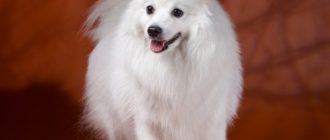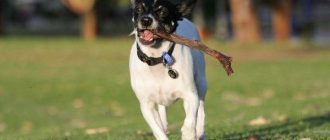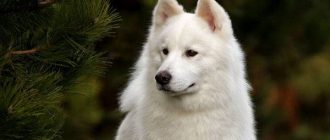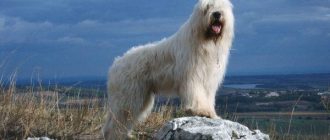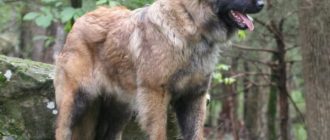Assessment of breed characteristics
Contents
| Adaptability Definition of how easy a dog is. can adapt to changes in life. |  |
| Shedding Level Level and frequency of hair loss in animal. |  |
| Level of tenderness Level and amount of tenderness and affection that the dog gives back in return for attention to itself. |  |
| Need for Exercise Daily Activity Level dogs. |  |
| Social need Required number of dog contacts with other animals as well as people. |  |
| Housing ratio Factor that determines the level of noise and other inconvenience that the dog can deliver to the owners in the ratio apartment size to dog size. |  |
| Grooming Number of bathing, combing, as well as necessary number of professional grooming sessions required the dog. |  |
| Friendliness in an unfamiliar environment society with strangers or in an unfamiliar environment. |  |
| The tendency to bark The tendency to bark and its frequency and volume. |  |
| Health Issues Potential Health Status dogs. |  |
| Territorial tendency of the dog to protect his house, yard or even a car owner. |  |
| Cat friendliness A trend towards cat tolerance and reduced manifestation of hunting instincts. |  |
| Intelligence Dog’s ability to think and solve emerging difficulties (not to be confused with learning!). |  |
| Education and training Level of difficulty in training a dog perform certain actions. |  |
| Friendliness for children Factor determining how much the dog friendly to children, whether she likes to play with them and endure some children’s pranks. |  |
| Game activity The concept is determined by its very name, and, usually found in almost all dogs. |  |
| Observing Dog’s ability to detect presence a stranger in his territory. |  |
| Friendliness for other dogs Dog’s tendency to find common language with other relatives. |  |
Brief description of the breed
The heroine of this article is a hunting gun dog originally from Baltic Estonia. The winning benefits of the Estonian hound impeccable flair and poise of character are considered. ABOUT the melody and strength of the voice of the Estonian hound is sometimes debated with side of the hunters. Although in terms of musicality barking she loses some beagle breeds (the same Russian hound), Estonian hound always readily, distinctively and loudly announces the owner of the whereabouts of the game. Most often, hounds from the Baltic States are attracted to prey duck, hare, fox (sometimes artiodactyls). From six months these small but strong and smart dogs are capable of showing their first results during the capture of the beast. But love Estonian hounds not only in hunting circles – they are also able to play the role of beautiful and very obedient pets. Estonians quite friendly to people, have good character and devotion. And their dimensions (height up to 52 cm, weight up to 25 kg) and unpretentious care allow the owner to keep the dog even in a small living space. Although the owners are hunters speak out in favor of living the hounds closer to nature. Estonian hounds are strong, dry dogs. Head shape rounded, superciliary arches markedly pronounced. Going from forehead to long muzzle smooth. The ears of Estonian hounds of low set, medium thickness, hanging. Dark brown eyes almond-shaped. Scissor bite. The neck is muscular, dry, no suspension (in general, not typical for Estonian hounds skin folds). The torso is straight, with developed muscles, in the croup area is slightly sloping. Limbs are bony, very strong. The tail is not shorter than the hock, wide in diameter at the base, narrow towards the end. Colors of Estonian hounds – black-piebald, brown-piebald and black-piebald in blush. Estonians wool short, stiff, weakly expressed undercoat.
Photo of Estonian hound:
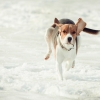

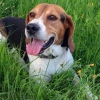
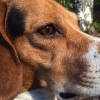

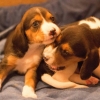
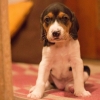 Photo of dogs of the Estonian Hound breed |
Photo of dogs of the Estonian Hound breed |
Origin history
Breeding began on the territory of the Estonian SSR (then back in composition of the Union republics of the USSR) in the first half of the 20th century. The founder of the breed is called the canine dog S.A. Smelkov, who gave more than 20 years in breeding medium-sized Estonian hounds. The need for breeding appeared because of the Baltic climatic conditions and the ban on use in hunting tall hounds whose height exceeded 45 cm. Dogs were required for hunting, compact in size, hardy, unpretentious, with voiced voices. To local Estonian hounds breeders added blood to the beagles to fix a small stature, Lucerne hounds, ready to bring trophies from half a year (or even earlier), English foxhounds characterized by tirelessness and lively temperament, Russian hounds, known for their melodious and powerful barking, Finnish hounds – keen prey for game (hares, foxes, raccoons, deer). Until 1954, painstaking work was carried out to remove breed and select the best individuals for breeding in the future. The first breed standard was approved in 1959. In the early 1960s in the entire Soviet Union spread evil to game, but gentle and loyal to man Estonian hounds.
Character of estonian hound
In the absence of education gaps, Estonians grow up good, unobtrusive animals friendly to the owner’s family (even to kids). Other animals in the house are patiently treated if the very appearance of the puppy, the owner will take care that in cats, dogs or rodents, the dog will see an equal member of the family, not the game to be chased. The hounds from Estonia are wonderful grasp the elements of learning, rarely are stubborn. Indefatigable and physically strong, they can drive the beast for many hours. Experienced hunters praise Estonian hounds for beautiful performance of work to pursue the beast, regardless of weather conditions, terrain complexity. Will attract the Estonian hound to hunting or not, the owner should be aware of that it is always an active, agile dog, therefore a constant spending time in four walls is not suitable for her. mis-educated Estonian hound may succumb own hunting instinct, chasing any to animals. It’s not far from trouble, especially if nearby Busy highway. Besides obedience follows from an early age accustom the Estonian hound to a clear delineation of “friend or foe”. A dog that is too trusting in people can suffer by taking to for example, treats from the ill-wisher. Therefore, the puppy should to have one indisputable leader – his own master.
Maintenance and care
These hounds coexist perfectly almost everywhere – in the apartment, on fresh air in areas of country and private houses (need roomy aviary and insulated booth), in hunting farms. They easily tolerate almost any temperature (exception – severe frosts, because their undercoat is rather scarce). By the way when keeping such a dog in the apartment at times, deterioration is noted flair in the presence of drafts, in determining the place for sleep and resting dogs near the kitchen. Negative effect on flair various smelling agents – paint, varnish, deodorizing substances. Care of a coat of Estonian hounds is not implies special difficulties. Just comb them out weekly (or more often) with a brush for wire-haired dogs. During spring and autumn molt combing should be carried out daily, massaging the skin, removing dead hairs, particles of skin. Bathe Estonian hounds should be contaminated, but not necessary this in cases where the dog’s coat is clean enough. Grabs sometimes washing paws, especially in cases where the Estonian hound – this is a companion dog, does not take part in the hunt. Eye cleaning, ears, teeth, clipping – these procedures should become a habit in a dog since its appearance in the house. The owner will have to follow behind all the possible dangerous symptoms that speak of the disease (jumps in body temperature, vomiting, constipation, diarrhea, refusal to take food and water). At the first suspicion of a disease, you should contact vet clinic or call a doctor at home. It is advisable to purchase components for a first-aid kit, because sometimes help should be rendered as soon as possible. About medication should consult with veterinarian who will carry out preventive examinations dogs (at least once every six months or a year). Based on inspection, considering age, hereditary diseases of the animal, the veterinarian will prescribe drugs that are most suitable for a particular pet. As food for the Estonian hound does not fit food from the owner’s table. If a the owner has a sufficient supply of time, you can give preference for natural food – meat and offal, vegetables and cereal, sour-milk products (with such a diet is necessary taking vitamin preparations under the supervision of a veterinarian). Easier choose balanced dry food as a diet. True in economy-class industrial feeds will be more harmful than good. Therefore, it is preferable to feed extra-premium level and holistic. The dog must always have access to a bowl of clean water. (especially in the heat).
Training and education
Estonian hound can just walk with the owner of the basics training (OKD – General view of training), recognizing such commands, like: “Nearby”, “Place”, “It is impossible”, “Walk”, “Stand”, “Lie” and others. After OKD, the animal will be obedient and problem-free for family and others. Experienced breeders note that Estonian the hounds are highly trained and disciplined. But before you start training for teams, the dog must undergo adaptation to life in new conditions. From the very first days, the Estonian hound puppy is not only gets to know the owner’s family members (and other animals if those are available), but also gets used to new sounds, house smells. Even the puppy should not be allowed to sleep in the master’s bed, beg for food, bite the furniture, because in adulthood wean the dog from bad behavior will be much more difficult. If an Estonian hound acquired as an assistant in the hunt, then its training should be also practice right after the puppy gets used to the new family, and trust will be established between the owner and the dog relationship. Starting to learn hunting is required, when the animal learns a series of basic commands. Parenting hunting dogs has a number of nuances. For example, eating Estonian hound should occur after filed by the owner signal of a hunting horn or a bugle – one of the attributes of a canine hunting (when a hunter calls a dog with a peculiar melodic sound). So subsequently the animal will be easier associate the sound of a horn with the need to appear to the owner. In addition, the owner is a hunter from an early age (when a puppy all necessary vaccinations will be made) should take with him dog when planning an outing in nature. Having learned the area, on which, probably, there will be a capture of game, the Estonian hound will subsequently navigate better and faster when it comes time. Whatever fate is chosen by the owner – so that his four-legged friend brilliantly played the role of a hunting friend dogs or pleased the domestic, this breed will always be movement required. Not boring short walks, but full exhausting workouts. Successfully Estonian hounds are engaged agility, frisbee escorting a host while cycling walking or jogging. The owner of the Estonian hound must ban raise your hand or scream at the dog. Representatives of such breeds are one of the most non-whimsical and executive, therefore excessive anger on the part of the owner hurts them, makes doubt their own abilities.
Health and Disease
Estonian hounds live on the order of 10-12 years, are not weak in health are. The main problems of the breed are considered: problems motor apparatus due to strong physical exertion (arthritis, dislocations, torn ligaments, etc.), diseases of the hearing organs (otitis media, otodectosis, etc.).

